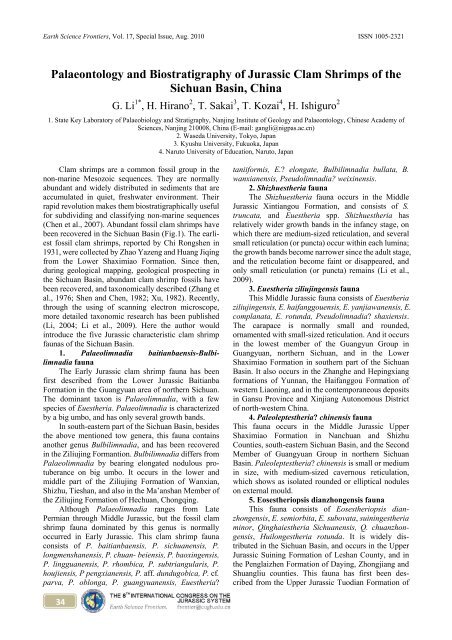in Jurassic and Cretaceous Stratigraphy
in Jurassic and Cretaceous Stratigraphy
in Jurassic and Cretaceous Stratigraphy
You also want an ePaper? Increase the reach of your titles
YUMPU automatically turns print PDFs into web optimized ePapers that Google loves.
Earth Science Frontiers, Vol. 17, Special Issue, Aug. 2010 ISSN 1005-2321<br />
Palaeontology <strong>and</strong> Biostratigraphy of <strong>Jurassic</strong> Clam Shrimps of the<br />
Sichuan Bas<strong>in</strong>, Ch<strong>in</strong>a<br />
34<br />
G. Li 1* , H. Hirano 2 , T. Sakai 3 , T. Kozai 4 , H. Ishiguro 2<br />
1. State Key Laboratory of Palaeobiology <strong>and</strong> <strong>Stratigraphy</strong>, Nanj<strong>in</strong>g Institute of Geology <strong>and</strong> Palaeontology, Ch<strong>in</strong>ese Academy of<br />
Sciences, Nanj<strong>in</strong>g 210008, Ch<strong>in</strong>a (E-mail: gangli@nigpas.ac.cn)<br />
2. Waseda University, Tokyo, Japan<br />
3. Kyushu University, Fukuoka, Japan<br />
4. Naruto University of Education, Naruto, Japan<br />
Clam shrimps are a common fossil group <strong>in</strong> the<br />
non-mar<strong>in</strong>e Mesozoic sequences. They are normally<br />
abundant <strong>and</strong> widely distributed <strong>in</strong> sediments that are<br />
accumulated <strong>in</strong> quiet, freshwater environment. Their<br />
rapid revolution makes them biostratigraphically useful<br />
for subdivid<strong>in</strong>g <strong>and</strong> classify<strong>in</strong>g non-mar<strong>in</strong>e sequences<br />
(Chen et al., 2007). Abundant fossil clam shrimps have<br />
been recovered <strong>in</strong> the Sichuan Bas<strong>in</strong> (Fig.1). The earli-<br />
est fossil clam shrimps, reported by Chi Rongshen <strong>in</strong><br />
1931, were collected by Zhao Yazeng <strong>and</strong> Huang Jiq<strong>in</strong>g<br />
from the Lower Shaximiao Formation. S<strong>in</strong>ce then,<br />
dur<strong>in</strong>g geological mapp<strong>in</strong>g, geological prospect<strong>in</strong>g <strong>in</strong><br />
the Sichuan Bas<strong>in</strong>, abundant clam shrimp fossils have<br />
been recovered, <strong>and</strong> taxonomically described (Zhang et<br />
al., 1976; Shen <strong>and</strong> Chen, 1982; Xu, 1982). Recently,<br />
through the us<strong>in</strong>g of scann<strong>in</strong>g electron microscope,<br />
more detailed taxonomic research has been published<br />
(Li, 2004; Li et al., 2009). Here the author would<br />
<strong>in</strong>troduce the five <strong>Jurassic</strong> characteristic clam shrimp<br />
faunas of the Sichuan Bas<strong>in</strong>.<br />
1. Palaeolimnadia baitianbaensis-Bulbi-<br />
limnadia fauna<br />
The Early <strong>Jurassic</strong> clam shrimp fauna has been<br />
first described from the Lower <strong>Jurassic</strong> Baitianba<br />
Formation <strong>in</strong> the Guangyuan area of northern Sichuan.<br />
The dom<strong>in</strong>ant taxon is Palaeolimnadia, with a few<br />
species of Euestheria. Palaeolimnadia is characterized<br />
by a big umbo, <strong>and</strong> has only several growth b<strong>and</strong>s.<br />
In south-eastern part of the Sichuan Bas<strong>in</strong>, besides<br />
the above mentioned tow genera, this fauna conta<strong>in</strong>s<br />
another genus Bulbilimnadia, <strong>and</strong> has been recovered<br />
<strong>in</strong> the Ziliuj<strong>in</strong>g Formantion. Bulbilimnadia differs from<br />
Palaeolimnadia by bear<strong>in</strong>g elongated nodulous pro-<br />
tuberance on big umbo. It occurs <strong>in</strong> the lower <strong>and</strong><br />
middle part of the Ziliuj<strong>in</strong>g Formation of Wanxian,<br />
Shizhu, Tieshan, <strong>and</strong> also <strong>in</strong> the Ma’anshan Member of<br />
the Ziliuj<strong>in</strong>g Formation of Hechuan, Chongq<strong>in</strong>g.<br />
Although Palaeolimnadia ranges from Late<br />
Permian through Middle <strong>Jurassic</strong>, but the fossil clam<br />
shrimp fauna dom<strong>in</strong>ated by this genus is normally<br />
occurred <strong>in</strong> Early <strong>Jurassic</strong>. This clam shrimp fauna<br />
consists of P. baitianbaensis, P. sichuanensis, P.<br />
longmenshanensis, P. chuan- beiensis, P. baox<strong>in</strong>gensis,<br />
P. l<strong>in</strong>gguanensis, P. rhombica, P. subtriangularis, P.<br />
houjiensis, P pengxianensis, P. aff. dundugobica, P. cf.<br />
parva, P. oblonga, P. guangyuanensis, Euestheria?<br />
taniiformis, E.? elongate, Bulbilimnadia bullata, B.<br />
wanxianensis, Pseudolimnadia? weix<strong>in</strong>ensis.<br />
2. Shizhuestheria fauna<br />
The Shizhuestheria fauna occurs <strong>in</strong> the Middle<br />
<strong>Jurassic</strong> X<strong>in</strong>tiangou Formation, <strong>and</strong> consists of S.<br />
truncata, <strong>and</strong> Euestheria spp. Shizhuestheria has<br />
relatively wider growth b<strong>and</strong>s <strong>in</strong> the <strong>in</strong>fancy stage, on<br />
which there are medium-sized reticulation, <strong>and</strong> several<br />
small reticulation (or puncta) occur with<strong>in</strong> each lum<strong>in</strong>a;<br />
the growth b<strong>and</strong>s become narrower s<strong>in</strong>ce the adult stage,<br />
<strong>and</strong> the reticulation become fa<strong>in</strong>t or disappeared, <strong>and</strong><br />
only small reticulation (or puncta) rema<strong>in</strong>s (Li et al.,<br />
2009).<br />
3. Euestheria ziliuj<strong>in</strong>gensis fauna<br />
This Middle <strong>Jurassic</strong> fauna consists of Euestheria<br />
ziliuj<strong>in</strong>gensis, E. haifanggouensis, E. yanjiawanensis, E.<br />
complanata, E. rotunda, Pseudolimnadia? shaxiensis.<br />
The carapace is normally small <strong>and</strong> rounded,<br />
ornamented with small-sized reticulation. And it occurs<br />
<strong>in</strong> the lowest member of the Guangyun Group <strong>in</strong><br />
Guangyuan, northern Sichuan, <strong>and</strong> <strong>in</strong> the Lower<br />
Shaximiao Formation <strong>in</strong> southern part of the Sichuan<br />
Bas<strong>in</strong>. It also occurs <strong>in</strong> the Zhanghe <strong>and</strong> Hep<strong>in</strong>gxiang<br />
formations of Yunnan, the Haifanggou Formation of<br />
western Liaon<strong>in</strong>g, <strong>and</strong> <strong>in</strong> the contemporaneous deposits<br />
<strong>in</strong> Gansu Prov<strong>in</strong>ce <strong>and</strong> X<strong>in</strong>jiang Autonomous District<br />
of north-western Ch<strong>in</strong>a.<br />
4. Paleoleptestheria? ch<strong>in</strong>ensis fauna<br />
This fauna occurs <strong>in</strong> the Middle <strong>Jurassic</strong> Upper<br />
Shaximiao Formation <strong>in</strong> Nanchuan <strong>and</strong> Shizhu<br />
Counties, south-eastern Sichuan Bas<strong>in</strong>, <strong>and</strong> the Second<br />
Member of Guangyuan Group <strong>in</strong> northern Sichuan<br />
Bas<strong>in</strong>. Paleoleptestheria? ch<strong>in</strong>ensis is small or medium<br />
<strong>in</strong> size, with medium-sized cavernous reticulation,<br />
which shows as isolated rounded or elliptical nodules<br />
on external mould.<br />
5. Eosestheriopsis dianzhongensis fauna<br />
This fauna consists of Eosestheriopsis dian-<br />
zhongensis, E. semiorbita, E. subovata, su<strong>in</strong><strong>in</strong>gestheria<br />
m<strong>in</strong>or, Q<strong>in</strong>ghaiestheria Sichuanensis, Q. chuanzhon-<br />
gensis, Huilongestheria rotunda. It is widely dis-<br />
tributed <strong>in</strong> the Sichuan Bas<strong>in</strong>, <strong>and</strong> occurs <strong>in</strong> the Upper<br />
<strong>Jurassic</strong> Su<strong>in</strong><strong>in</strong>g Formation of Leshan County, <strong>and</strong> <strong>in</strong><br />
the Penglaizhen Formation of Day<strong>in</strong>g, Zhongjiang <strong>and</strong><br />
Shuangliu counties. This fauna has first been des-<br />
cribed from the Upper <strong>Jurassic</strong> Tuodian Formation of

















